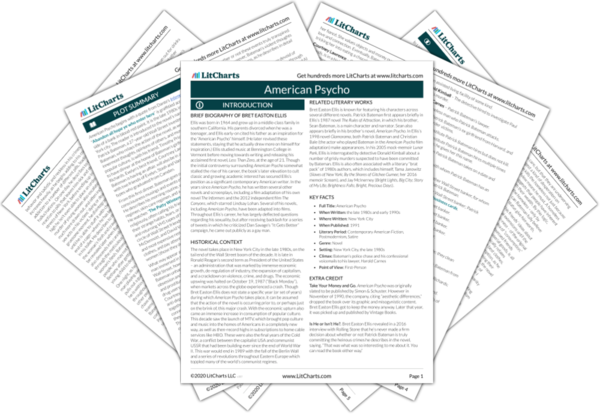Summary
Analysis
Bateman is sitting in a taxi. This morning, he reluctantly had a decadent breakfast with two colleagues, but had a lot on his mind, like helping America’s schools and getting tickets to see Sting in The Threepenny Opera on Broadway. Driving through Manhattan, the taxi pulls up next to another taxi, and Bateman sees sitting inside another colleague of his whose identity he is unsure of. Quickly, the cars both take off.
Bateman is starting not to enjoy even his favorite things, like fine dining, though his daydreaming during conversations with others is nothing new. The glimpse he has of a colleague, though he is unsure of his identity, is a brief moment of comparison, with the glass of the window separating the Bateman of the current moment from the group of colleagues he once felt such a part of.
Themes
Bateman notices his taxi driver (whose name, he reads, is Abdullah) staring at him. Bateman notes the man’s clogged pores and ingrown hair, but doesn’t think anything of his stare—that is, until Abdullah asks him outright, “Don’t I know you?” Bateman insists he doesn’t, but the driver asks his name. Bateman gives Abdullah a fake one and tells him he must recognize him because he’s an actor and model, but he doesn’t take the bait. “I’ve seen your face somewhere,” he tells him. After a while, Abdullah tells Bateman he knows who he is.
As is by now expected, there is a moment here of identity confusion. However, it’s not that Bateman is being confused for someone else, but being recognized. In a rare moment, he is being seen and identified—and at least some of his crimes are seemingly confirmed as occurring in the real world. Though Bateman can usually use his privilege to dominate someone like a taxi driver, his efforts here are unsuccessful.
Themes
Abdullah starts driving quickly and dangerously, running through red lights and taking strange routes. Bateman wants to get out, and considers asking him to stop immediately and let him out, but he’s frozen. Abdullah finally tells Bateman, “You’re the guy who kill Solly.” Abdullah tells Bateman his face is on a wanted poster downtown. Bateman chokes up, attempting to speak, and say that he’s going to take down Abdullah’s license number. Abdullah starts to get incredibly angry and turns the taxi off the highway and toward a deserted parking area. Bateman still finds himself unable to move or respond.
Bateman finds himself completely at the mercy of Abdullah. Whereas he normally would be in control of a situation like this, especially one with someone who he views as so much less valuable than him, he is now helpless. For the first time in the novel, Bateman is recognized for and seems about to face justice for one of his crimes. This moment, a jarring change from the rest of the novel, also gives new information regarding the truth: if there are posters downtown with Bateman’s face from the night of the big chase, maybe it really did happen? Maybe Bateman only partially exaggerated things?
Themes
Bateman is finally able to speak, telling Abdullah that he’s incorrectly identified him, but Abdullah turns around with a gun and demands Bateman’s Rolex watch, then his wallet and cash. All this time, Bateman is cowering and Abdullah is shouting, swearing, and debasing him. Bateman threatens to call and have Abdullah’s license revoked, but Abdullah knows he won’t do this because he’s guilty. Bateman tries to pull a knife on Abdullah, but it is useless and he’s forced to turn over even his sunglasses. Bateman calls Abdullah a dead man, and Abdullah calls him a “yuppie scumbag,” asking, “Which is worse?” As Bateman walks back to the highway, he chokes up, saying to himself, “I just want to keep the game going,” and sees a homeless beggar walking out from behind a poster for The Threepenny Opera.
Here the tables are drastically turned. Bateman is quite literally stripped of his shallow material possessions by a man who he considers to have much less status and value than himself. It appears as if the structure of Bateman’s life and world are coming crashing down completely in this one moment. Finally, someone has not only rightfully accused Bateman of his crimes, but stood up to him, not bending to his intimidation or attempts to buy favor. His final exchange with Abdullah, though heavy-handed, raises the question: is a life like Bateman’s even worth living? The final image, of the homeless woman coming from behind the poster, also demonstrates the change in Bateman’s world: earlier, that poster would have undoubtedly been for “Les Misérables.”
Themes
Get the entire American Psycho LitChart as a printable PDF.













